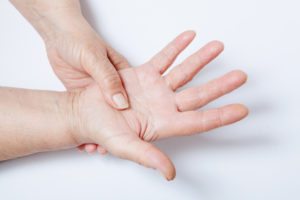Dupuytren’s Disease: Signs and Symptoms

Dupuytren’s disease, also known as Dupuytren’s contracture is a condition that affects the flexibility of the hands, which can significantly impair everyday functioning. Typically, the disease affects individuals over the age of 40 and is caused by a thickening in the tissues underneath the palm. The beginnings of Dupuytren’s disease may not cause much discomfort but as the condition progresses, a complete loss in functionality to the hands can occur.
If you believe you are at risk for contracting Dupuytren’s disease, whether due to an underlying medical condition or heredity, there are a few signs to look out for. If you experience one or more of these symptoms, it may be time to contact Dr Damon Thomas for an evaluation.
THE FIRST SIGNS
Dupuytren’s disease is often characterised by the finger(s) becoming flexed toward the palm of the hand. The condition worsens very slowly and will usually begin with thickened skin on the palm. The most notable sign of Dupuytren’s disease is nodules or lumps that appear underneath the skin on the palm of the hand. These nodules are thickening in the natural fascia layer in the palm and fingers. Left untreated, these inflexible cords are what cause the fingers to permanently bend.
As the nodules form, there may be some discomfort in the hand but eventually any pain subsides. In general, Dupuytren’s disease is not a painful condition but it causes a large everyday hindrance for those who have it. Simple acts like picking up a pen, swiping a credit card or tying your shoes can be difficult if not impossible when the fingers lose their dexterity, particularly since the condition has a tendency to affect both hands. The little and ring fingers are usually the most commonly affected with the thumb and index fingers rarely becoming involved.
AVAILABLE TREATMENT OPTIONS
Although the specific causes of Dupuytren’s are still unknown, there are treatment options that can restore flexibility to the fingers and help your hands regain their natural functionality. One of the most common options is surgery, which involves excising the cords that are causing the fingers to bend.
A less invasive treatment option consists of a collagenase injection. Receiving an injection can be beneficial for those who want to avoid surgery and have a faster recovery. Dr Thomas is certified to administer this injection and also has years of experience performing hand surgery for those suffering from Dupuytren’s disease.
Once your procedure is complete, Dr Thomas will have you return to his office so that he can assess the progress of your procedure. With treatment, you can go back to doing your everyday activities with improved comfort and ease. If you would like more information about Dupuytren’s disease and the treatment options that are available to you, feel free to call Dr Damon Thomas on (03) 9508 9508.
MAKING AN INFORMED DECISION
Our website is intended to provide general information about hand surgery and should not be used as a substitute for personalised medical advice. It is important to consult with a qualified plastic surgeon to determine if hand surgery is the right procedure for you. The following considerations should be part of your decision-making process.
Risks
All surgical procedures carry risk. The potential risks and complications associated with hand surgery include, but are not limited to, bleeding, infection, nerve damage, stiffness, loss of feeling or movement of the hand or fingers, scarring, and the need for additional surgery. It is important to understand the risks involved and weigh up the benefits and drawbacks of surgery before undergoing hand surgery.
Recovery
Recovery time after hand surgery may vary depending on the individual, the extent of the procedure, and the technique used. In general, patients should be prepared to experience some discomfort, swelling, and limited mobility after surgery. Patients must also be prepared to take time off work and other activities (including exercise) and follow post-operative instructions to promote proper healing and minimise the risk of complications.
Results
Individual results may vary depending on a number of factors, including the patient’s natural hand structure, the patient’s lifestyle, and the surgical technique employed. It is critical to have realistic expectations about the outcome of hand surgery and understand that each patient’s outcome will be unique. A physical therapy rehabilitation program after hand surgery is often crucial to regain function and improve range of motion.
If you have any questions or concerns about hand surgery, please do not hesitate to contact us.
